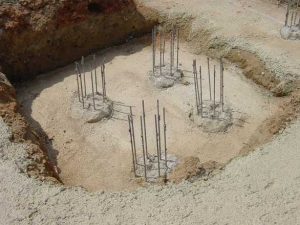Using or being able to identify the correct types of foundation needed for a particular building project can mean the difference between success and failure. Without a solid foundation, any walls or other structures are liable to move over time, and even collapse if the ground is unsuitable enough. Understanding the type of foundation your house has been built on is also important, especially if you are planning to carry out extensive improvements or renovations.
The type of foundation your house is built on will depend on several factors, including the age of the property, the type of ground on which it sits, and even the overall size and height of the structure. But in all cases, the job of a foundation is to distribute the weight that needs to be carried over a larger surface area.
Trench Foundations
Suitable for: Soil, Chalk, Gravel and Sand, Clay
A common foundation type is the Trench Foundation, sometimes also called Trenchfill. Channels are dug into the ground beneath where the exterior load-bearing walls will sit. This is then filled with concrete, sometimes with reinforced steel bars first inserted, to create a solid foundation. The depth of a trench foundation needed depends on the size of the building and the surrounding ground type. Internal load-bearing walls may also require trench foundations to be used.
Strip Foundations
Suitable for: Soil, Chalk, Gravel and Sand, Clay
Similar to trench foundations, Strip Foundations also use a trench dug into the surrounding ground, but less concrete is poured into this, and the wall is started from below the surface level. The lower levels of the wall will often be built with blocks rather than bricks. Strip foundations are not often used to support main load-bearing walls of a house, but may be useful for providing support for a series of pillars, where individual pad foundations are not possible.
Wide Strip Foundations
Where the soil being built on is especially soft or has a low load-bearing capacity, Wide Strip Foundations may be used. These help to spread the load over a larger area, and are usually reinforced with steel bars.
Raft Foundations
Suitable for: Soil, Peat, Reclaimed Ground
Raft Foundations consist of a solid slab of concrete, reinforced with a mesh of steel bars, which covers the whole footprint of the building. If your house has internal concrete floors, it is likely built on a raft foundation. Raft foundations will often be thicker around the outside, where the load-bearing walls will sit. Modern raft foundations will also include one or more layers of insulation, making them extremely good at helping to retain heat in the property. Raft foundations are often used where the underlying soil is soft or loose, as loads are spread over a wider area, and is often a viable alternative to the more expensive Pile Foundations.
Pile Foundations
Suitable for: Reclaimed Ground, Soft Chalk
 Deep holes are drilled into the soil (sometimes several metres deep) beneath where the walls of the building will be, and then usually fitted with reinforced steel frames and filled with concrete. A precast, reinforced concrete beam then tops the piles and provides a solid base for walls. This creates a very solid foundation, and is mostly used in areas where there is a high likelihood of the ground settling over time.
Deep holes are drilled into the soil (sometimes several metres deep) beneath where the walls of the building will be, and then usually fitted with reinforced steel frames and filled with concrete. A precast, reinforced concrete beam then tops the piles and provides a solid base for walls. This creates a very solid foundation, and is mostly used in areas where there is a high likelihood of the ground settling over time.
Pad Foundations
Suitable for: Soil, Clay, Chalk
Mainly used when isolated loads need to be supported, such as the upright columns in a steel-framed or post and beam frame house. The load on the foundation is concentrated in a small area, but is usually spread further up the frame.







